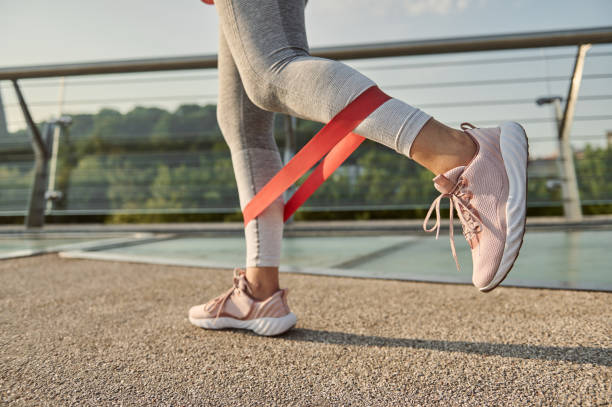
Resistance Bands: The Ultimate Fitness Tools for Men and Women
Resistance bands are versatile, portable, and highly effective tools for building strength, improving flexibility, and increasing endurance. Whether you’re a seasoned athlete or a fitness beginner, resistance bands offer a wide range of exercises that cater to various fitness goals. These elastic bands are becoming a staple in home and gym workouts, and for good reason—they’re lightweight, inexpensive, and can be used virtually anywhere.
In this blog, we’ll explore what resistance bands are, their benefits, and why they are considered perfect Fitness Tools for Men and Women. Additionally, we’ll dive into key topics such as resistance levels, how to use them, and the different types of resistance bands.
What Are Resistance Bands?
Resistance bands are elastic loops or tubes made from latex or synthetic rubber. They come in different sizes, thicknesses, and resistance levels, which determine how difficult it is to stretch them. Unlike traditional weights, which rely on gravity, resistance bands provide tension throughout the entire range of motion. This allows you to work your muscles in a different way, providing a balanced and effective workout.
Benefits of Resistance Bands
Portable and Convenient
Chest Expander Band are lightweight and easy to carry, making them perfect for home workouts, travel, or even the office. You don’t need a dedicated space or bulky gym equipment to get a full-body workout.
Versatile
These bands can target almost every muscle group, including arms, legs, chest, back, and core. They are effective for various workout styles such as strength training, pilates, yoga, and physical therapy.
Cost-Effective
Compared to weights and other fitness machines, resistance bands are highly affordable. Even a complete set with different resistance levels will cost significantly less than most gym memberships or home equipment.
Perfect for All Fitness Levels
Resistance bands come in different resistance levels, allowing everyone from beginners to advanced athletes to find a suitable option. This versatility makes them ideal Fitness Tools for Men and Women of all fitness levels.
Key Types of Resistance Bands and How to Use Them
Therapy Bands
Therapy bands are thin and wide and are commonly used for rehabilitation and physical therapy. These bands offer light to medium resistance and are often recommended for injury recovery and mobility exercises.
Loop Bands
Loop bands form a continuous loop and are generally used for lower body exercises. They can be wrapped around the thighs or ankles to target muscles in the legs and glutes. Loop bands are great for squats, lunges, and lateral walks.
Tube Bands with Handles
Tube resistance bands come with handles at each end and are perfect for upper body workouts. These bands mimic traditional gym equipment like dumbbells and cable machines, allowing you to perform bicep curls, shoulder presses, and chest flies.
Figure 8 Bands
As the name suggests, these bands are shaped like a figure eight and typically have soft handles on each side. They are primarily used for upper body exercises such as rows and arm presses, offering a unique way to work your muscles.
Power Bands
Power resistance bands are long and heavy-duty. They are often used for strength training, particularly for exercises that mimic weightlifting movements. Power bands are also popular in CrossFit and can be looped around a pull-up bar to assist with pull-ups.
Resistance Levels
Resistance bands are color-coded by their resistance levels, which usually range from light to heavy. Here’s a quick breakdown:
- Light (5-15 lbs): Ideal for beginners, rehabilitation, and mobility exercises. These bands are also excellent for warm-ups.
- Medium (15-30 lbs): Suitable for those who want a moderate workout. Medium resistance bands offer a good balance for both upper and lower body exercises.
- Heavy (30-50 lbs): Designed for advanced users. These bands are perfect for strength training, especially for larger muscle groups like the legs and back.
- Extra Heavy (50+ lbs): Best suited for very advanced fitness enthusiasts who want to challenge their strength with high-resistance training.
How to Incorporate Resistance Bands Into Your Workout
Resistance bands can be used for a variety of exercises to target different muscle groups. Here are a few examples:
- Upper Body: Use tube Elastic Fitness Resistance Band with handles for bicep curls, chest presses, and tricep extensions. These movements will tone and build upper body strength without the need for weights.
- Lower Body: Loop bands can be incorporated into squats, glute bridges, and lunges to work the legs and glutes. For an added challenge, place the band just above your knees to increase the intensity.
- Core: Engage your core by using a resistance band in plank variations or seated twists. This will not only strengthen your abs but also improve your balance and stability.
- Full Body Workouts: For a full-body workout, try combining resistance band exercises. For example, do a squat with a bicep curl or a lunge with a shoulder press to work multiple muscle groups at once.
Why Resistance Bands Are the Perfect Fitness Tools for Men and Women
Resistance bands are suitable for everyone, regardless of fitness level or workout goals. Whether you want to build strength, improve flexibility, or rehab an injury, these bands can help you get there. Their versatility, portability, and cost-effectiveness make them the ultimate Fitness Tools for Men and Women.
Moreover, because resistance bands come in different types and resistance levels, they can easily be adjusted to meet your fitness needs. From beginners seeking to improve mobility to advanced athletes aiming for muscle growth, resistance bands provide an excellent workout for both men and women alike.
Conclusion
Resistance bands are an essential addition to any workout routine. They offer numerous benefits, including versatility, portability, and affordability, making them perfect Fitness Tools for Men and Women. Whether you’re using them for strength training, rehabilitation, or flexibility exercises, resistance bands can help you achieve your fitness goals. Start incorporating these bands into your workouts today to experience the difference they can make!





Leave Your Comment